Analyzing Management and Organizations in a Global Environment
VerifiedAdded on 2023/06/08
|7
|1597
|124
Essay
AI Summary
This essay examines the influence of organizational culture on business strategies, highlighting the importance of maintaining a strong organizational culture for overall performance. It discusses how organizational culture reveals the character of an organization through its values, beliefs, and norms. Different types of organizational cultures, such as hierarchical, market, adhocracy, and clan cultures, are explored, detailing their impact on strategy and employee management. The essay further emphasizes that organizational culture is revealed through repeated actions and shapes the values of the organization, with definitions varying based on individual comprehension. The analysis concludes that organizational culture is a major factor in the successful implementation of strategies, contributing significantly to an organization's overall performance and societal contribution.
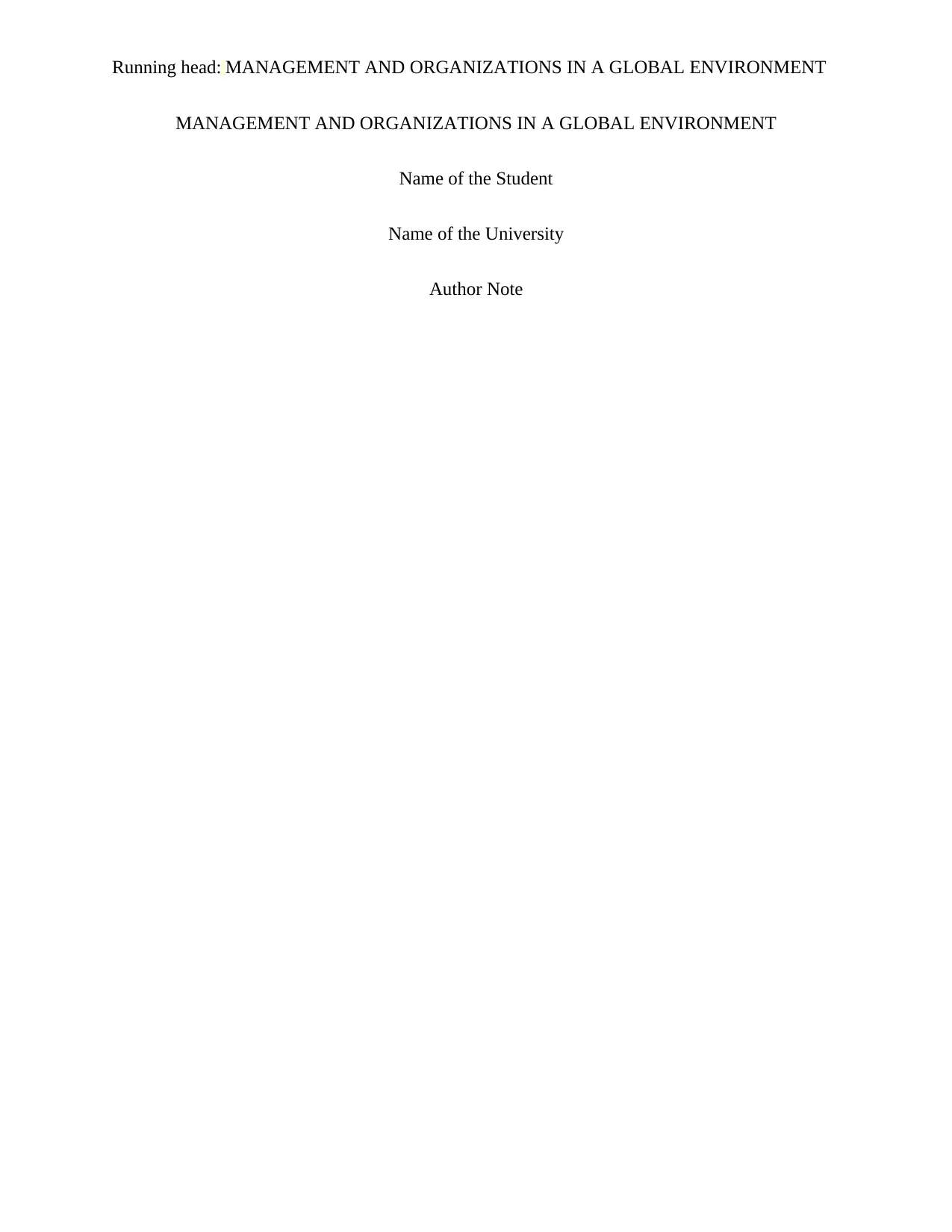
Running head: MANAGEMENT AND ORGANIZATIONS IN A GLOBAL ENVIRONMENT
MANAGEMENT AND ORGANIZATIONS IN A GLOBAL ENVIRONMENT
Name of the Student
Name of the University
Author Note
MANAGEMENT AND ORGANIZATIONS IN A GLOBAL ENVIRONMENT
Name of the Student
Name of the University
Author Note
Paraphrase This Document
Need a fresh take? Get an instant paraphrase of this document with our AI Paraphraser
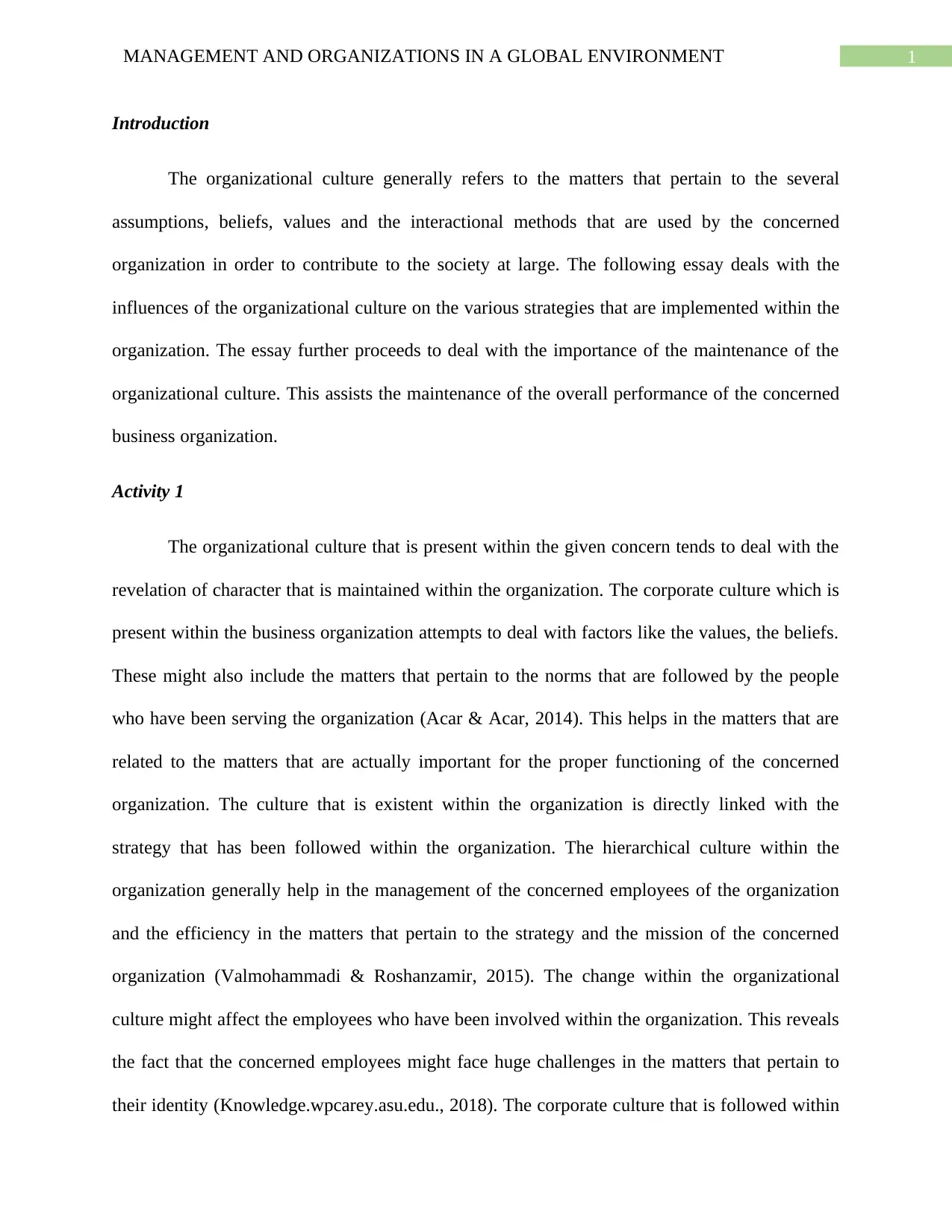
1MANAGEMENT AND ORGANIZATIONS IN A GLOBAL ENVIRONMENT
Introduction
The organizational culture generally refers to the matters that pertain to the several
assumptions, beliefs, values and the interactional methods that are used by the concerned
organization in order to contribute to the society at large. The following essay deals with the
influences of the organizational culture on the various strategies that are implemented within the
organization. The essay further proceeds to deal with the importance of the maintenance of the
organizational culture. This assists the maintenance of the overall performance of the concerned
business organization.
Activity 1
The organizational culture that is present within the given concern tends to deal with the
revelation of character that is maintained within the organization. The corporate culture which is
present within the business organization attempts to deal with factors like the values, the beliefs.
These might also include the matters that pertain to the norms that are followed by the people
who have been serving the organization (Acar & Acar, 2014). This helps in the matters that are
related to the matters that are actually important for the proper functioning of the concerned
organization. The culture that is existent within the organization is directly linked with the
strategy that has been followed within the organization. The hierarchical culture within the
organization generally help in the management of the concerned employees of the organization
and the efficiency in the matters that pertain to the strategy and the mission of the concerned
organization (Valmohammadi & Roshanzamir, 2015). The change within the organizational
culture might affect the employees who have been involved within the organization. This reveals
the fact that the concerned employees might face huge challenges in the matters that pertain to
their identity (Knowledge.wpcarey.asu.edu., 2018). The corporate culture that is followed within
Introduction
The organizational culture generally refers to the matters that pertain to the several
assumptions, beliefs, values and the interactional methods that are used by the concerned
organization in order to contribute to the society at large. The following essay deals with the
influences of the organizational culture on the various strategies that are implemented within the
organization. The essay further proceeds to deal with the importance of the maintenance of the
organizational culture. This assists the maintenance of the overall performance of the concerned
business organization.
Activity 1
The organizational culture that is present within the given concern tends to deal with the
revelation of character that is maintained within the organization. The corporate culture which is
present within the business organization attempts to deal with factors like the values, the beliefs.
These might also include the matters that pertain to the norms that are followed by the people
who have been serving the organization (Acar & Acar, 2014). This helps in the matters that are
related to the matters that are actually important for the proper functioning of the concerned
organization. The culture that is existent within the organization is directly linked with the
strategy that has been followed within the organization. The hierarchical culture within the
organization generally help in the management of the concerned employees of the organization
and the efficiency in the matters that pertain to the strategy and the mission of the concerned
organization (Valmohammadi & Roshanzamir, 2015). The change within the organizational
culture might affect the employees who have been involved within the organization. This reveals
the fact that the concerned employees might face huge challenges in the matters that pertain to
their identity (Knowledge.wpcarey.asu.edu., 2018). The corporate culture that is followed within
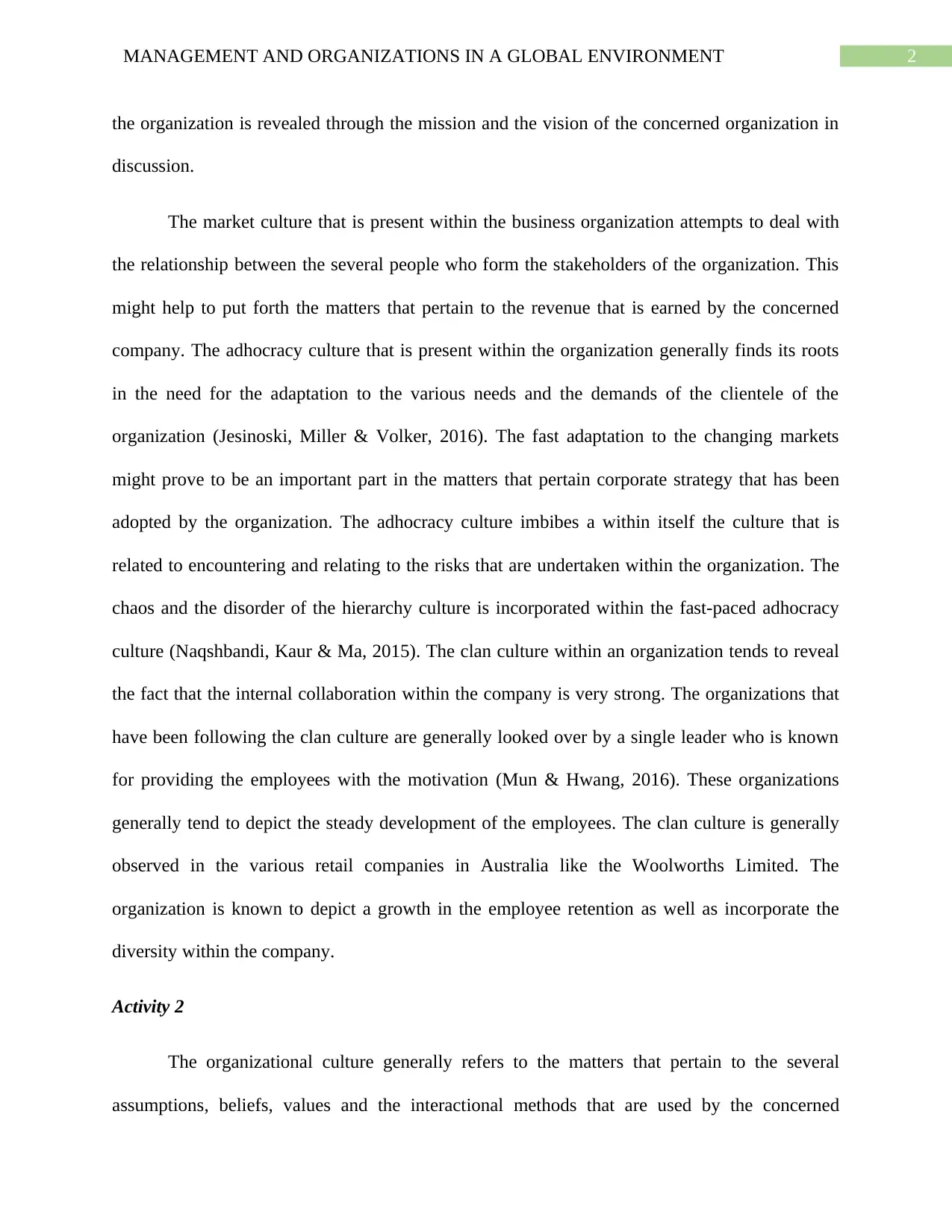
2MANAGEMENT AND ORGANIZATIONS IN A GLOBAL ENVIRONMENT
the organization is revealed through the mission and the vision of the concerned organization in
discussion.
The market culture that is present within the business organization attempts to deal with
the relationship between the several people who form the stakeholders of the organization. This
might help to put forth the matters that pertain to the revenue that is earned by the concerned
company. The adhocracy culture that is present within the organization generally finds its roots
in the need for the adaptation to the various needs and the demands of the clientele of the
organization (Jesinoski, Miller & Volker, 2016). The fast adaptation to the changing markets
might prove to be an important part in the matters that pertain corporate strategy that has been
adopted by the organization. The adhocracy culture imbibes a within itself the culture that is
related to encountering and relating to the risks that are undertaken within the organization. The
chaos and the disorder of the hierarchy culture is incorporated within the fast-paced adhocracy
culture (Naqshbandi, Kaur & Ma, 2015). The clan culture within an organization tends to reveal
the fact that the internal collaboration within the company is very strong. The organizations that
have been following the clan culture are generally looked over by a single leader who is known
for providing the employees with the motivation (Mun & Hwang, 2016). These organizations
generally tend to depict the steady development of the employees. The clan culture is generally
observed in the various retail companies in Australia like the Woolworths Limited. The
organization is known to depict a growth in the employee retention as well as incorporate the
diversity within the company.
Activity 2
The organizational culture generally refers to the matters that pertain to the several
assumptions, beliefs, values and the interactional methods that are used by the concerned
the organization is revealed through the mission and the vision of the concerned organization in
discussion.
The market culture that is present within the business organization attempts to deal with
the relationship between the several people who form the stakeholders of the organization. This
might help to put forth the matters that pertain to the revenue that is earned by the concerned
company. The adhocracy culture that is present within the organization generally finds its roots
in the need for the adaptation to the various needs and the demands of the clientele of the
organization (Jesinoski, Miller & Volker, 2016). The fast adaptation to the changing markets
might prove to be an important part in the matters that pertain corporate strategy that has been
adopted by the organization. The adhocracy culture imbibes a within itself the culture that is
related to encountering and relating to the risks that are undertaken within the organization. The
chaos and the disorder of the hierarchy culture is incorporated within the fast-paced adhocracy
culture (Naqshbandi, Kaur & Ma, 2015). The clan culture within an organization tends to reveal
the fact that the internal collaboration within the company is very strong. The organizations that
have been following the clan culture are generally looked over by a single leader who is known
for providing the employees with the motivation (Mun & Hwang, 2016). These organizations
generally tend to depict the steady development of the employees. The clan culture is generally
observed in the various retail companies in Australia like the Woolworths Limited. The
organization is known to depict a growth in the employee retention as well as incorporate the
diversity within the company.
Activity 2
The organizational culture generally refers to the matters that pertain to the several
assumptions, beliefs, values and the interactional methods that are used by the concerned
⊘ This is a preview!⊘
Do you want full access?
Subscribe today to unlock all pages.

Trusted by 1+ million students worldwide
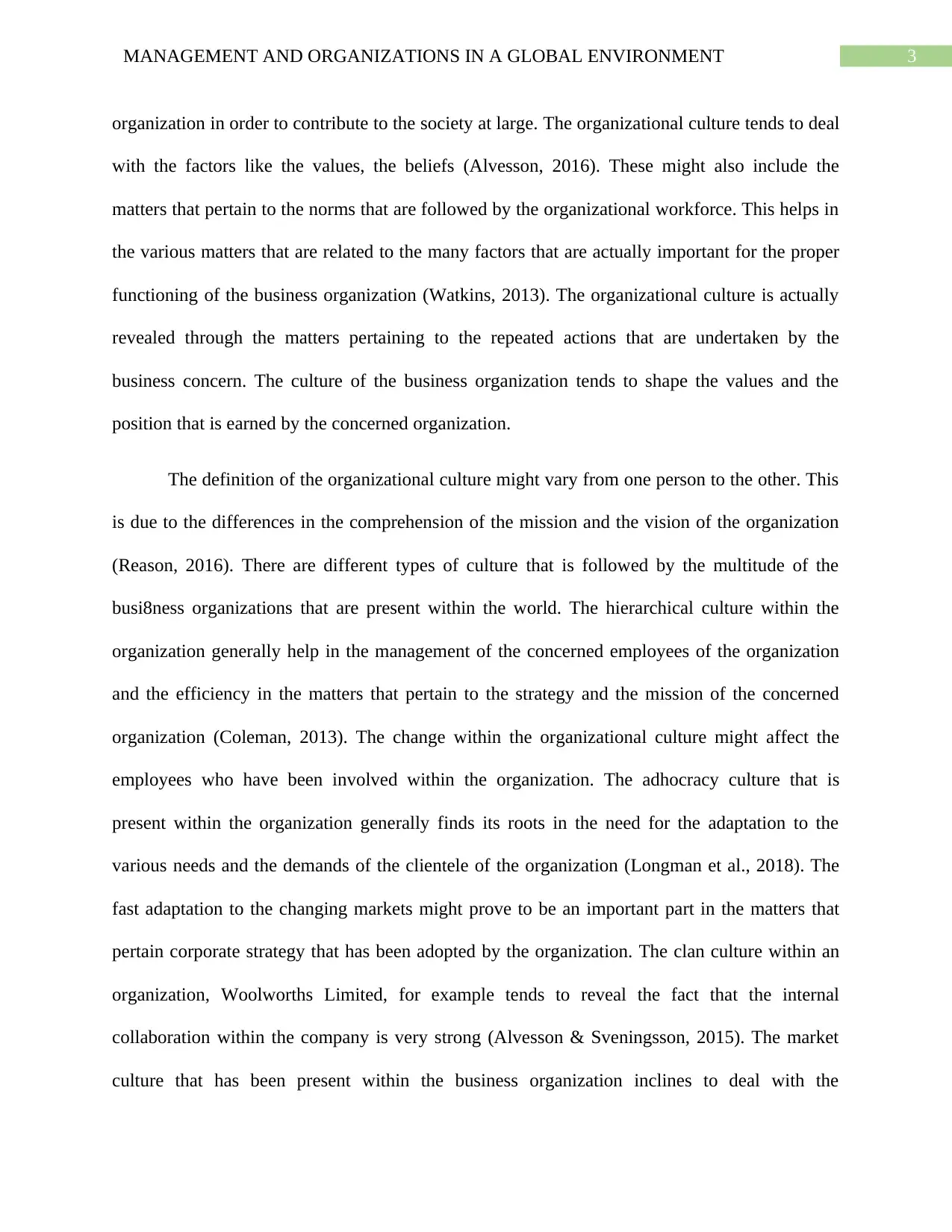
3MANAGEMENT AND ORGANIZATIONS IN A GLOBAL ENVIRONMENT
organization in order to contribute to the society at large. The organizational culture tends to deal
with the factors like the values, the beliefs (Alvesson, 2016). These might also include the
matters that pertain to the norms that are followed by the organizational workforce. This helps in
the various matters that are related to the many factors that are actually important for the proper
functioning of the business organization (Watkins, 2013). The organizational culture is actually
revealed through the matters pertaining to the repeated actions that are undertaken by the
business concern. The culture of the business organization tends to shape the values and the
position that is earned by the concerned organization.
The definition of the organizational culture might vary from one person to the other. This
is due to the differences in the comprehension of the mission and the vision of the organization
(Reason, 2016). There are different types of culture that is followed by the multitude of the
busi8ness organizations that are present within the world. The hierarchical culture within the
organization generally help in the management of the concerned employees of the organization
and the efficiency in the matters that pertain to the strategy and the mission of the concerned
organization (Coleman, 2013). The change within the organizational culture might affect the
employees who have been involved within the organization. The adhocracy culture that is
present within the organization generally finds its roots in the need for the adaptation to the
various needs and the demands of the clientele of the organization (Longman et al., 2018). The
fast adaptation to the changing markets might prove to be an important part in the matters that
pertain corporate strategy that has been adopted by the organization. The clan culture within an
organization, Woolworths Limited, for example tends to reveal the fact that the internal
collaboration within the company is very strong (Alvesson & Sveningsson, 2015). The market
culture that has been present within the business organization inclines to deal with the
organization in order to contribute to the society at large. The organizational culture tends to deal
with the factors like the values, the beliefs (Alvesson, 2016). These might also include the
matters that pertain to the norms that are followed by the organizational workforce. This helps in
the various matters that are related to the many factors that are actually important for the proper
functioning of the business organization (Watkins, 2013). The organizational culture is actually
revealed through the matters pertaining to the repeated actions that are undertaken by the
business concern. The culture of the business organization tends to shape the values and the
position that is earned by the concerned organization.
The definition of the organizational culture might vary from one person to the other. This
is due to the differences in the comprehension of the mission and the vision of the organization
(Reason, 2016). There are different types of culture that is followed by the multitude of the
busi8ness organizations that are present within the world. The hierarchical culture within the
organization generally help in the management of the concerned employees of the organization
and the efficiency in the matters that pertain to the strategy and the mission of the concerned
organization (Coleman, 2013). The change within the organizational culture might affect the
employees who have been involved within the organization. The adhocracy culture that is
present within the organization generally finds its roots in the need for the adaptation to the
various needs and the demands of the clientele of the organization (Longman et al., 2018). The
fast adaptation to the changing markets might prove to be an important part in the matters that
pertain corporate strategy that has been adopted by the organization. The clan culture within an
organization, Woolworths Limited, for example tends to reveal the fact that the internal
collaboration within the company is very strong (Alvesson & Sveningsson, 2015). The market
culture that has been present within the business organization inclines to deal with the
Paraphrase This Document
Need a fresh take? Get an instant paraphrase of this document with our AI Paraphraser
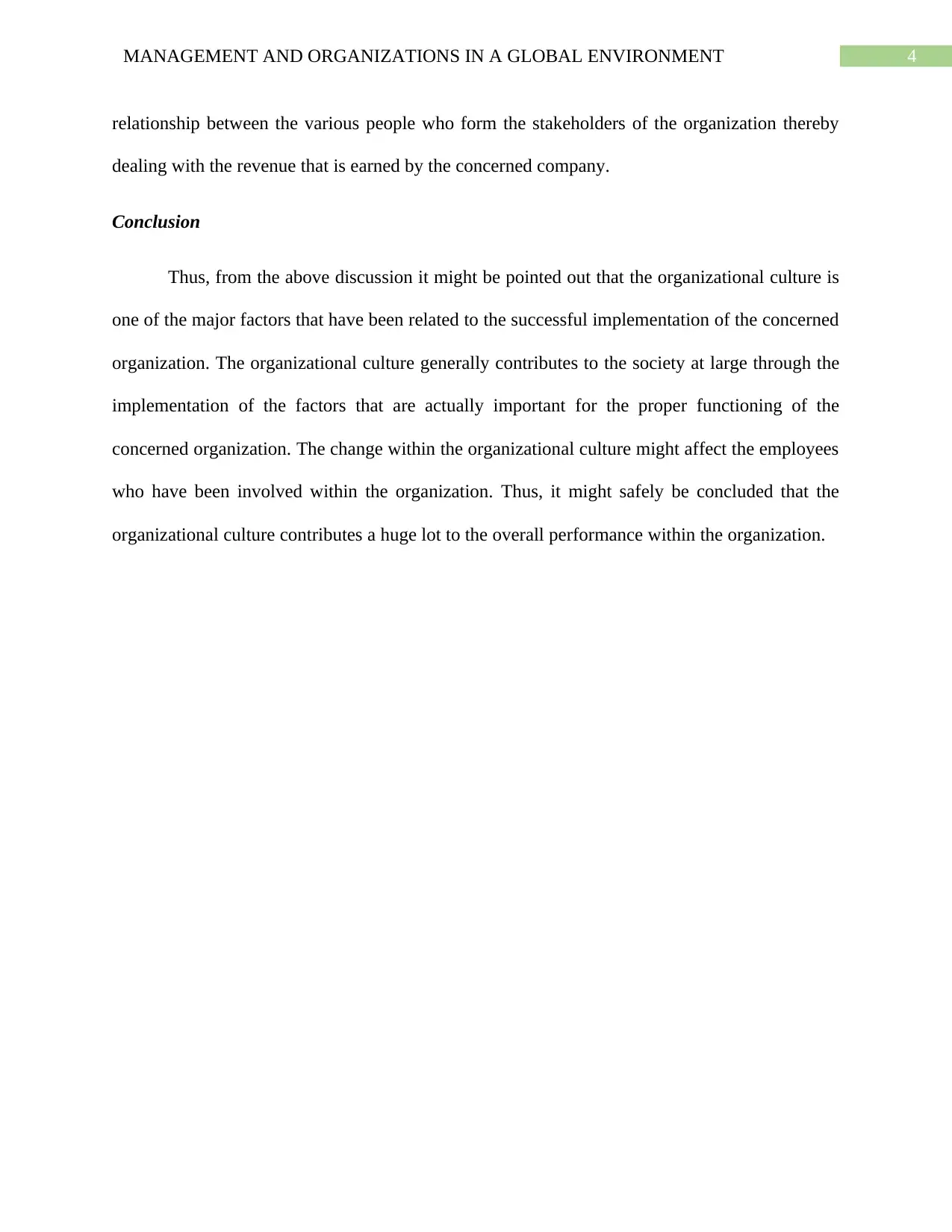
4MANAGEMENT AND ORGANIZATIONS IN A GLOBAL ENVIRONMENT
relationship between the various people who form the stakeholders of the organization thereby
dealing with the revenue that is earned by the concerned company.
Conclusion
Thus, from the above discussion it might be pointed out that the organizational culture is
one of the major factors that have been related to the successful implementation of the concerned
organization. The organizational culture generally contributes to the society at large through the
implementation of the factors that are actually important for the proper functioning of the
concerned organization. The change within the organizational culture might affect the employees
who have been involved within the organization. Thus, it might safely be concluded that the
organizational culture contributes a huge lot to the overall performance within the organization.
relationship between the various people who form the stakeholders of the organization thereby
dealing with the revenue that is earned by the concerned company.
Conclusion
Thus, from the above discussion it might be pointed out that the organizational culture is
one of the major factors that have been related to the successful implementation of the concerned
organization. The organizational culture generally contributes to the society at large through the
implementation of the factors that are actually important for the proper functioning of the
concerned organization. The change within the organizational culture might affect the employees
who have been involved within the organization. Thus, it might safely be concluded that the
organizational culture contributes a huge lot to the overall performance within the organization.
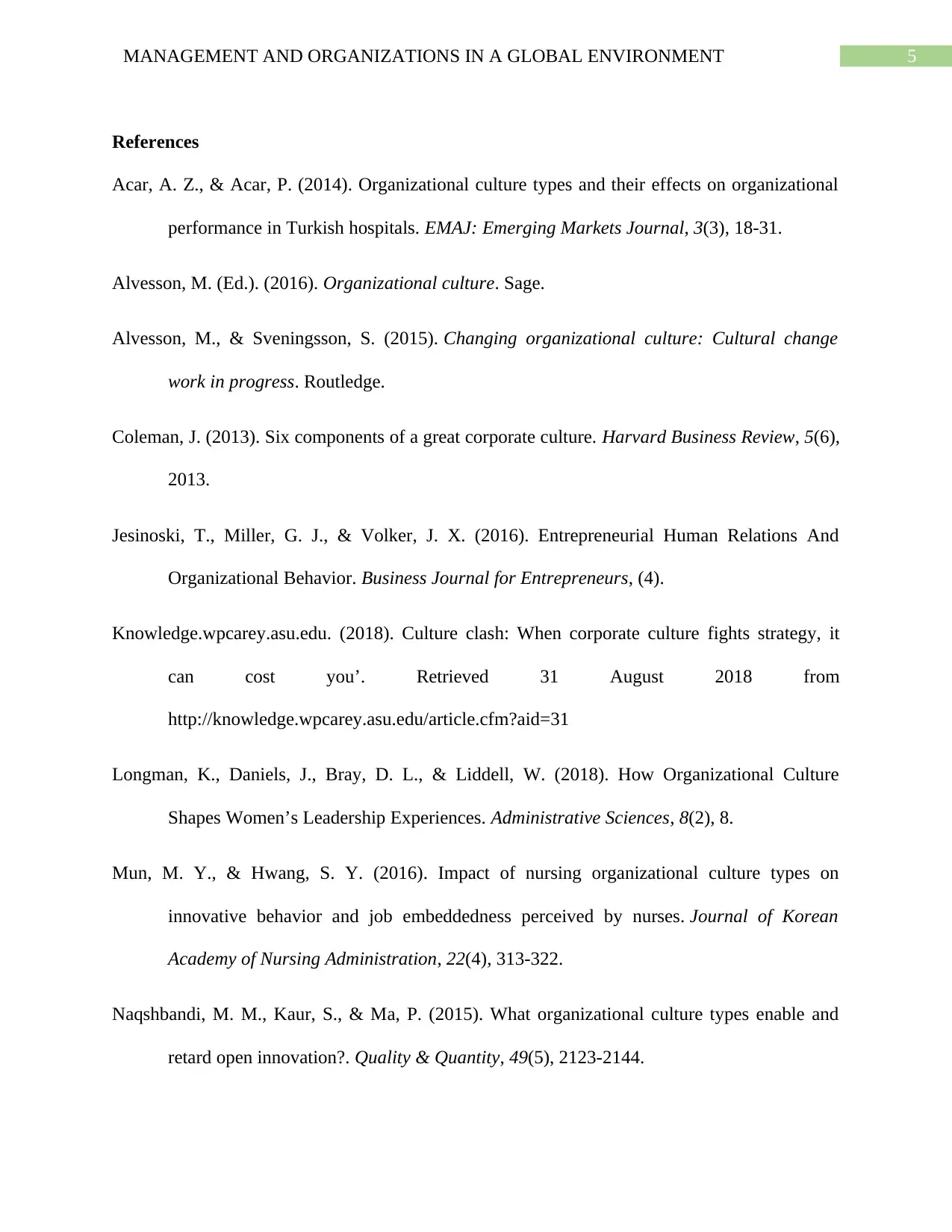
5MANAGEMENT AND ORGANIZATIONS IN A GLOBAL ENVIRONMENT
References
Acar, A. Z., & Acar, P. (2014). Organizational culture types and their effects on organizational
performance in Turkish hospitals. EMAJ: Emerging Markets Journal, 3(3), 18-31.
Alvesson, M. (Ed.). (2016). Organizational culture. Sage.
Alvesson, M., & Sveningsson, S. (2015). Changing organizational culture: Cultural change
work in progress. Routledge.
Coleman, J. (2013). Six components of a great corporate culture. Harvard Business Review, 5(6),
2013.
Jesinoski, T., Miller, G. J., & Volker, J. X. (2016). Entrepreneurial Human Relations And
Organizational Behavior. Business Journal for Entrepreneurs, (4).
Knowledge.wpcarey.asu.edu. (2018). Culture clash: When corporate culture fights strategy, it
can cost you’. Retrieved 31 August 2018 from
http://knowledge.wpcarey.asu.edu/article.cfm?aid=31
Longman, K., Daniels, J., Bray, D. L., & Liddell, W. (2018). How Organizational Culture
Shapes Women’s Leadership Experiences. Administrative Sciences, 8(2), 8.
Mun, M. Y., & Hwang, S. Y. (2016). Impact of nursing organizational culture types on
innovative behavior and job embeddedness perceived by nurses. Journal of Korean
Academy of Nursing Administration, 22(4), 313-322.
Naqshbandi, M. M., Kaur, S., & Ma, P. (2015). What organizational culture types enable and
retard open innovation?. Quality & Quantity, 49(5), 2123-2144.
References
Acar, A. Z., & Acar, P. (2014). Organizational culture types and their effects on organizational
performance in Turkish hospitals. EMAJ: Emerging Markets Journal, 3(3), 18-31.
Alvesson, M. (Ed.). (2016). Organizational culture. Sage.
Alvesson, M., & Sveningsson, S. (2015). Changing organizational culture: Cultural change
work in progress. Routledge.
Coleman, J. (2013). Six components of a great corporate culture. Harvard Business Review, 5(6),
2013.
Jesinoski, T., Miller, G. J., & Volker, J. X. (2016). Entrepreneurial Human Relations And
Organizational Behavior. Business Journal for Entrepreneurs, (4).
Knowledge.wpcarey.asu.edu. (2018). Culture clash: When corporate culture fights strategy, it
can cost you’. Retrieved 31 August 2018 from
http://knowledge.wpcarey.asu.edu/article.cfm?aid=31
Longman, K., Daniels, J., Bray, D. L., & Liddell, W. (2018). How Organizational Culture
Shapes Women’s Leadership Experiences. Administrative Sciences, 8(2), 8.
Mun, M. Y., & Hwang, S. Y. (2016). Impact of nursing organizational culture types on
innovative behavior and job embeddedness perceived by nurses. Journal of Korean
Academy of Nursing Administration, 22(4), 313-322.
Naqshbandi, M. M., Kaur, S., & Ma, P. (2015). What organizational culture types enable and
retard open innovation?. Quality & Quantity, 49(5), 2123-2144.
⊘ This is a preview!⊘
Do you want full access?
Subscribe today to unlock all pages.

Trusted by 1+ million students worldwide
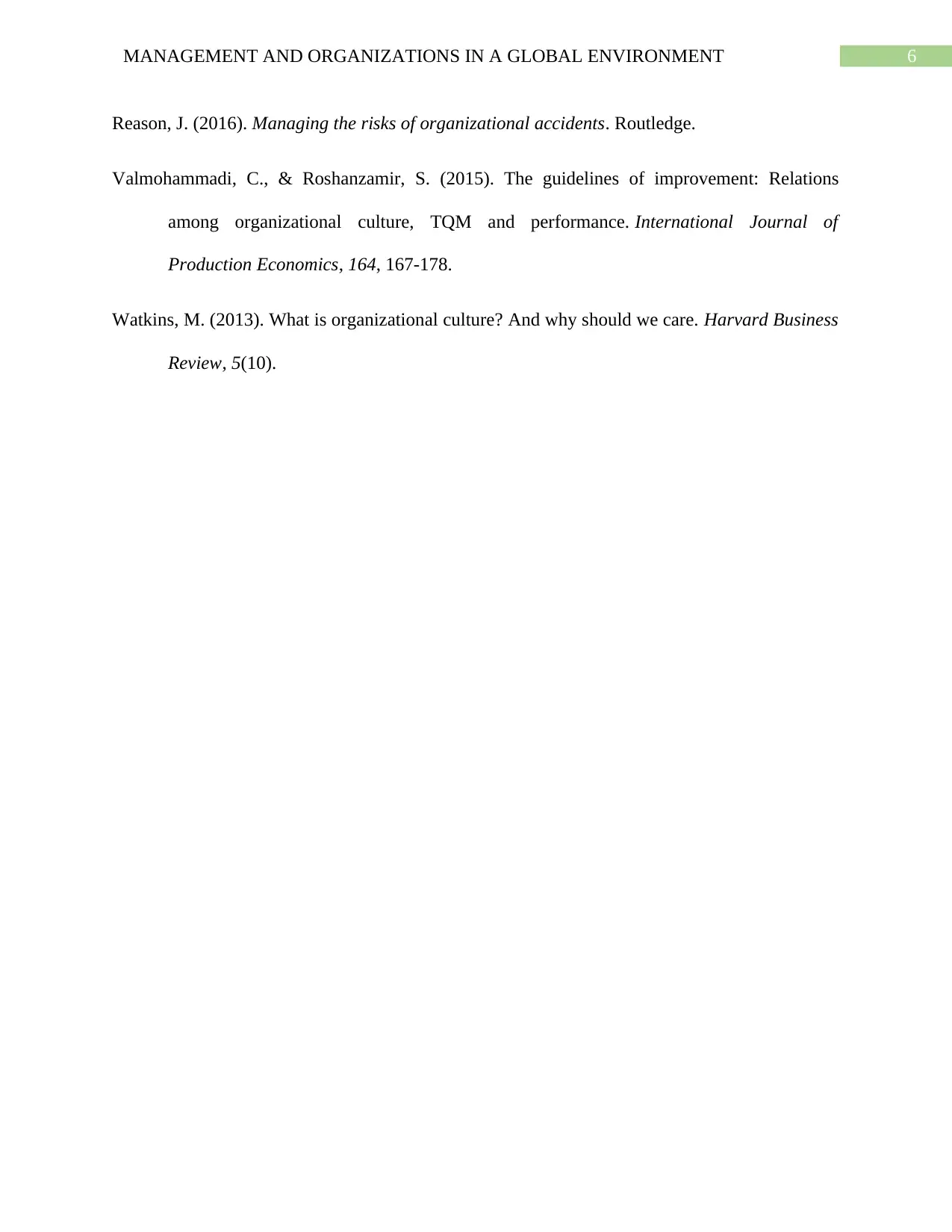
6MANAGEMENT AND ORGANIZATIONS IN A GLOBAL ENVIRONMENT
Reason, J. (2016). Managing the risks of organizational accidents. Routledge.
Valmohammadi, C., & Roshanzamir, S. (2015). The guidelines of improvement: Relations
among organizational culture, TQM and performance. International Journal of
Production Economics, 164, 167-178.
Watkins, M. (2013). What is organizational culture? And why should we care. Harvard Business
Review, 5(10).
Reason, J. (2016). Managing the risks of organizational accidents. Routledge.
Valmohammadi, C., & Roshanzamir, S. (2015). The guidelines of improvement: Relations
among organizational culture, TQM and performance. International Journal of
Production Economics, 164, 167-178.
Watkins, M. (2013). What is organizational culture? And why should we care. Harvard Business
Review, 5(10).
1 out of 7
Related Documents
Your All-in-One AI-Powered Toolkit for Academic Success.
+13062052269
info@desklib.com
Available 24*7 on WhatsApp / Email
![[object Object]](/_next/static/media/star-bottom.7253800d.svg)
Unlock your academic potential
Copyright © 2020–2025 A2Z Services. All Rights Reserved. Developed and managed by ZUCOL.




